Amaryllis are gorgeous and very easy to grow and care for, and you can enjoy them for many years to come.
In this comprehensive guide, I will show you everything you need to know about how to take care of an amaryllis.
You’ll learn what kind of light, water, soil, and fertilizer they need, plus get tips on pruning, propagation, troubleshooting common problems, and much more.
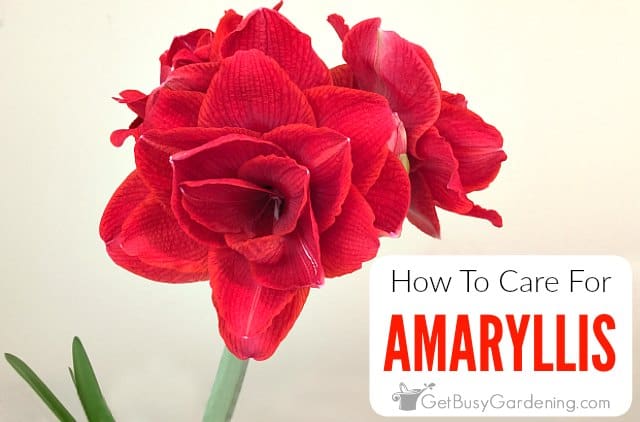
I don’t know about you, but I am a bit obsessed with amaryllis (I currently have 10 different ones growing in my spare bedroom!). I mean who doesn’t love those huge, gorgeous flowers?
The best part is that they bloom during the long winter months, which is something I look forward to every year.
Because of that, and their ease of care, amaryllis are popular gift plants around Christmas time and the holidays.
Below I’ll show you everything you need to know to keep yours thriving in your home or outdoors.
Amaryllis Quick Care Overview
| Scientific name: | Hippeastrum |
| Classification: | Tropical plant |
| Common names: | Amaryllis |
| Hardiness: | Zones 6-10, depending on the type |
| Temperature: | 65-80°F |
| Flowers: | Red, white, or pink blooms winter-summer |
| Light: | Full sun to partial shade, bright light indoors |
| Water: | Allow soil to dry between waterings, do not overwater |
| Humidity: | Medium-normal |
| Fertilizer: | Flowering plant food spring-summer |
| Soil: | Fast-draining, fertile soil |
| Common pests: | Mealybugs, fungus gnats |
Information About Amaryllis
Amaryllis, or Hippeastrum, are native to South Africa where, interestingly enough, they usually bloom in early spring. Depending on the type, they can reach 12-24″ tall.
Since it’s so easy to control the bloom time and grow them indoors, they became a popular Christmas flower.
They’re sometimes called a lily because of how they look, but are actually from the Amaryllidaceae family, and not even related to lilies.
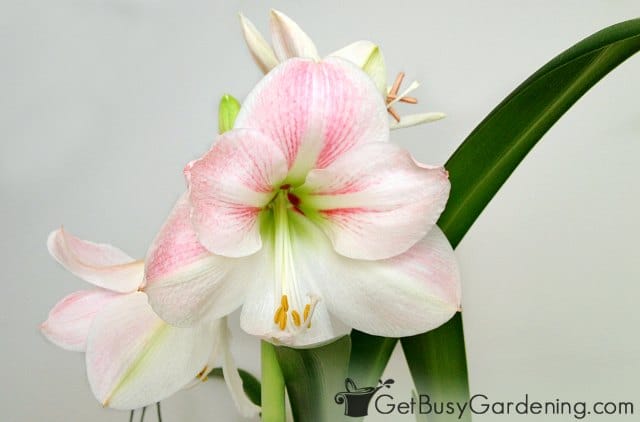
Different Types Of Amaryllis
There are hundreds of different types of amaryllis on the market these days, so you’ll have plenty to choose from.
Though red and white are the most common colors, they can be any shade of red, pink, or white. Some are even striped or multi-colored.
The size and shape of the flowers can be different depending on the variety too. Some are rounded, while others are star-shaped, and they can have either single or double petals.
A few of my favorites are ‘Apple Blossom’, ‘Clown’, ‘Splash’, ‘Red Lion’, and ‘Christmas Gift’.
Flowers
The prized amaryllis flowers grow on top of thick stems, and there can be 2-6 blossoms per stalk. Each bulb can produce 1-3 stalks per season.
The natural bloom time varies by variety, and it can be anywhere from late winter through summer. Though most people force your amaryllis to bloom during the early winter months.
The flowers get larger and more spectacular with age. They usually only flower once per year, though some can give you a surprise second bloom in the perfect conditions.
Toxicity
Unfortunately all parts of the amaryllis plant are toxic, so you should be careful where you grow them if you have pets.
The ASPCA.org website has them listed as being poisonous to both cats and dogs. So keep them out of reach of your pets (and the kiddos too) at all times if you’re concerned.
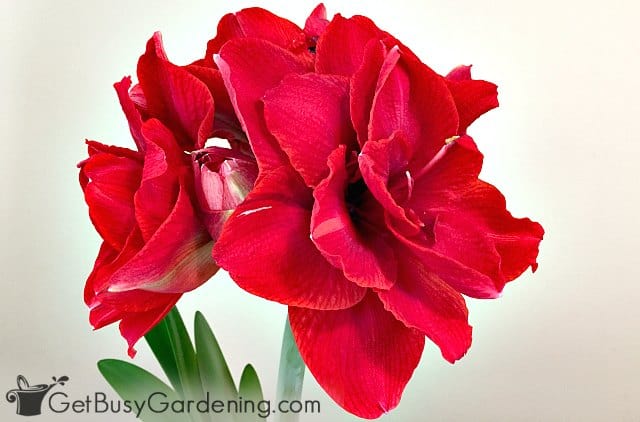
How To Care For An Amaryllis
The first step in successful amaryllis plant care is choosing the right location to grow them. Before you can do that, it’s important to understand what they need.
Hardiness
Even though it’s most common to find amaryllis for sale during the fall and winter, they are actually tender perennials that can’t handle the cold.
They will survive in zones 10 and above for sure. But there are a few hardy garden varieties that can survive down to zones 6 or 7.
If you live in a colder area, then you must bring them indoors during the winter. Otherwise, make sure you know the hardiness of the variety you have before planting it in your garden.
Where To Grow Amaryllis
If you live in a warm enough climate, you can grow them in your garden year round (lucky you!). Otherwise, you must keep them indoors through the winter.
Most people put them outside during the summer, and then bring them back inside in the fall.
Wherever you choose to grow them, they need fast-draining soil and a spot where they get lots of bright sunlight.
Related Post: How To Grow Amaryllis In Water
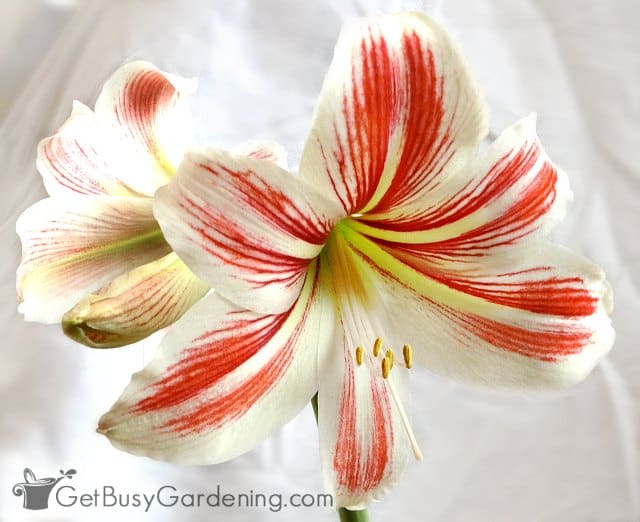
Amaryllis Plant Care & Growing Instructions
Now that you know where to grow them, let’s dive into the details of how to care for your amaryllis. These tips will ensure you’ll be able to keep yours thriving.
Watering
One of the most common problems people have with caring for an amaryllis is overwatering.
When they are kept consistently wet it will cause the bulb to rot, which will ultimately kill the plant.
They like to dry out between soakings, so pour water over the top until it starts coming out of the drainage holes. Then be sure to dump out all of the excess so they are never soaking in it.
If you struggle with giving them the right amount, I recommend getting an inexpensive moisture gauge to help you out.
Sunlight
It’s very important that your amaryllis gets enough sunlight, otherwise they can grow tall and leggy. They need full exposure, but will tolerate partial shade outdoors.
The ideal spot indoors is in a sunny, south-facing window. If you can’t give yours enough natural sunlight, then get a grow light and set it on an outlet timer for 6-10 hours a day.
For leggy flowers, use a stem stake to support them so they don’t fall over. You can also rotate the pot every few days to help keep them growing straight.
Fertilizer
Regular feedings are must as a regular part your amaryllis care routine. They need lots of nutrients in order to grow and bloom their best.
A general-purpose houseplant fertilizer will work great, or you can use one that is specifically made for flowering plants.
They also really love compost tea (which you can get in a concentrate, or buy tea bags to brew your own) and fish emulsion.
Begin fertilizing when it’s done blooming, and continue feeding through the summer. Stop in the fall, and don’t fertilize at all during dormancy or flowering.
Soil
They aren’t super fussy about the type of soil, as long as it has good drainage. A general purpose mix will work just fine for growing amaryllis.
However, if you tend to overwater, then I recommend adding in perlite or pumice and coarse sand into your medium to help add extra drainage.
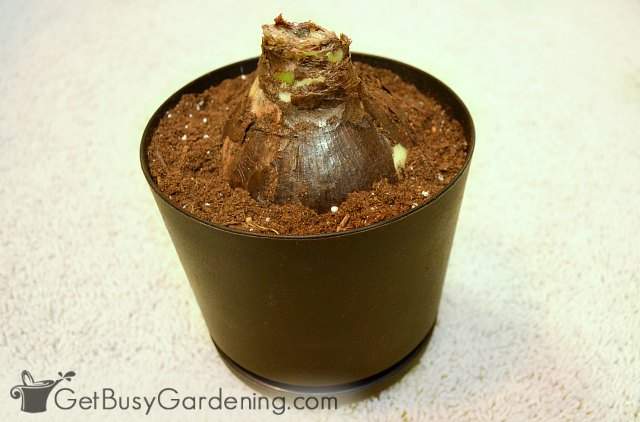
Temperature
The ideal temperature for growing amaryllis is between 65-80°F. But that range should vary depending on the time of the year.
When they’re blooming, it’s best to keep them cooler, between 55-65°F to make the flowers last longer. In the summer it should be between 70-80°F to help them grow faster.
During dormancy, the temperature should stay between 45-55°F to let it rest, and keep it from prematurely sprouting.
Repotting
Contrary to what you may have heard, you don’t need to repot amaryllis every year as part of their regular care. They actually prefer to be pot-bound.
The bulbs only need to repotted every few years at most, or if they have outgrown their container.
When it’s time to size them up, the best time to do it is the spring or after they’re done blooming. Choose a pot that’s 1-2″ larger and has drainage holes in the bottom.
Related Post: How To Grow Waxed Amaryllis Bulbs
Pest Control
Healthy amaryllis plants rarely have problems with pests, but mealybugs and fungus gnats can sometimes become a problem.
Fungus gnats are a sign that you are overwatering. To get rid of them, allow the soil to dry out more.
You can also use soapy water (I mix 1 tsp mild liquid soap to 1 liter of water) or insecticidal soap as a soil drench.
Neem oil works great to naturally kill bugs on the leaves and stems, and has a residual effect to keep them away.
Pruning
The good news is that you don’t have to worry too much about pruning as part of your regular amaryllis care routine.
You can deadhead the flowers as they fade, and cut the stem back all the way to the top of the bulb once all of them have died. Be sure to use a sharp and sterile pruners or precision shears.
It’s ok to trim any damaged leaves to keep the plant looking nice, but never completely remove any of the green or yellowing leaves.
They need to stay on as long as possible so the bulb can regenerate energy to bloom again next year. Wait until they shrivel and turn brown to cut them off.
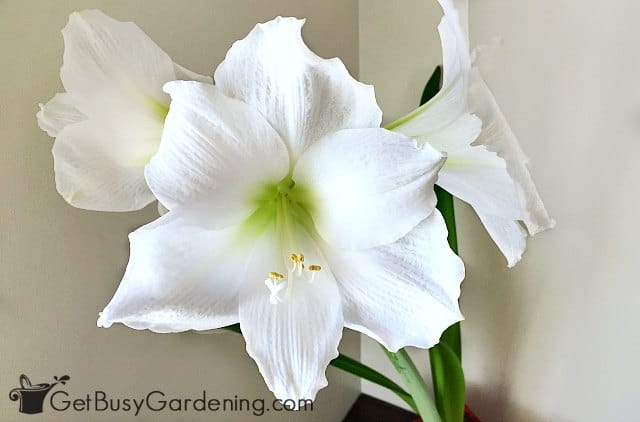
Dormancy
In their natural habitat, amaryllis bulbs go dormant during the cooler winter months. If you want them to flower reliably every year, it’s best to mimic this habit, rather than keep them growing year round.
They normally go dormant when the temps cool down in the fall or early winter. When this happens, the leaves will start to turn yellow, then eventually shrivel and die back completely.
The beauty of them is that it’s very easy for force dormancy and control the timing of the blooms, which is what most people like to do.
Related Post: How To Store Amaryllis Bulbs For The Winter
Amaryllis Propagation Tips
Dividing amaryllis bulbs is the easiest and most common method of propagation, but they can also be grown from seeds.
Mature bulbs will form offshoots around the base, which can be removed and planted into their own containers.
Seeds will take much longer to produce a sizable plant, and it will be a few years before they are large enough to flower.

Troubleshooting Common Amaryllis Problems
Once you get the hang of it, you’ll find that taking care of an amaryllis is pretty easy. But it can be very frustrating when yours starts having issues, and you don’t know why. My tips below will help you figure it out.
Amaryllis Not Flowering
There are a few reasons why an amaryllis will not flower. Most likely it’s because the bulb hasn’t built up sufficient energy.
This can happen when the leaves are cut off too early, from a lack or light or fertilizer, or the bulb is simply not mature enough.
Make sure they get plenty of full sun, fertilize them regularly from spring through summer, and never cut off the green leaves (unless of course you’re trying to force dormancy).
Related Post: Dormant Amaryllis Care, Timing, Preparation, and How To Revive It
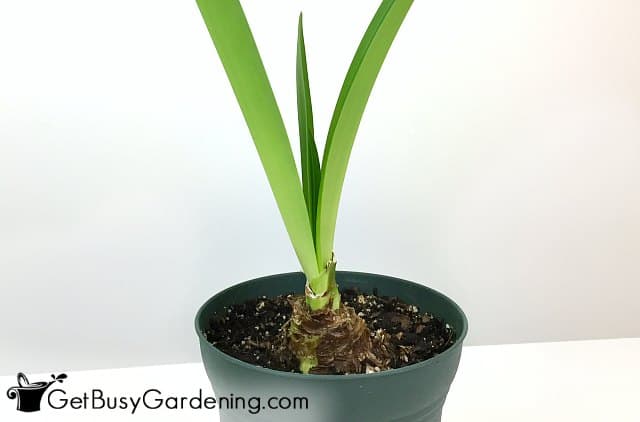
Droopy Leaves
Droopy amaryllis leaves could be caused by over or under watering, or not enough light.
Inspect the bulb to make sure it’s not rotting, then check the moisture level of the soil. If watering isn’t the issue, then give your plant more light.
Flowers Falling Over
Since the blossoms are so large, sometimes they can fall over once they open. The main problem is usually lack of light, which causes the stem to grow long, tall, and thin.
Move them to a sunnier location or add a grow light, and use a stem stake to support them. Or you can cut the flowers, and put the stems into a vase of water instead.
Leaves Turning Yellow
It’s normal for the leaves to turn yellow as the plant starts to go into dormancy (usually in the fall).
However, if your amaryllis gets yellow leaves during its active growing season, then it could be caused by overwatering or bulb rot.
Amaryllis Plant Care FAQs
Below I will answer some of the most common questions I get about amaryllis care. If you can’t find yours here, then please ask it in the comments section below.
How many years will an amaryllis bulb bloom?
An amaryllis bulb will bloom for many years, even several decades with the proper care. The flowers get bigger and more spectacular with age.
Does amaryllis come back every year?
An amaryllis will come back every year as long as you either grow it indoors over the winter, or plant a variety that’s hardy in your climate. Some are hardy down to zones 6-7, but most will only survive in z10+.
How many times a year do amaryllis bloom?
Amaryllis typically bloom only once per year, but many types can flower twice per year with the right care and perfect growing environment.
How long do amaryllis blooms last?
Individual amaryllis flowers will generally last for 2-3 weeks. The spikes will grow 3-6 flowers, and they will open at different times, making them last for 6-8 weeks or more. Depending on the type and age of the bulb, yours may grow more than one spike, making the bloom time last even longer.
Does amaryllis have a scent?
Yes, there are many types of fragrant amaryllis flowers, and some of the scents are stronger than others. It’s not overpowering, and you usually need to get close to notice the sweet scent.
Amaryllis care may sound like it’s overwhelming at first. But once you get the hang of it, you’ll see how easy it is. Just think, now that you know how, you’ll be able to enjoy these gorgeous flowers year after year!
If you want to learn all there is to know about maintaining healthy indoor plants, then you need my Houseplant Care eBook. It will show you everything you need to know about how to keep every plant in your home thriving. Download your copy now!
More Holiday Plant Care Guides
- How To Care For Holiday Cactus
- How To Care For Poinsettia Plants
- How To Care For A Christmas Cactus
- How To Care For A Thanksgiving Cactus Plant (Schlumbergera truncata)
- How To Take Care Of A Cyclamen Plant
- How To Care For An Easter Cactus Plant (Schlumbergera gaertneri)
Share your amaryllis care tips in the comments section below.
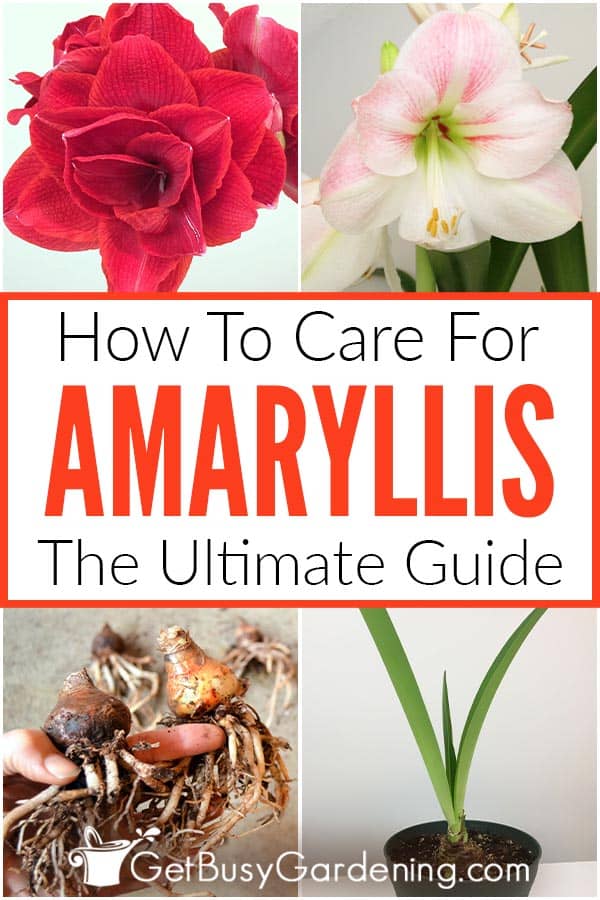
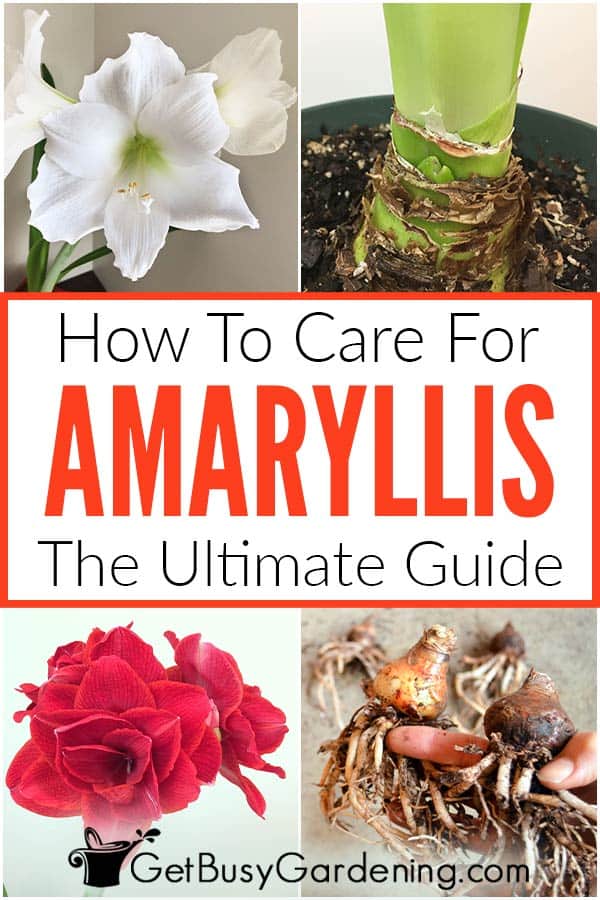
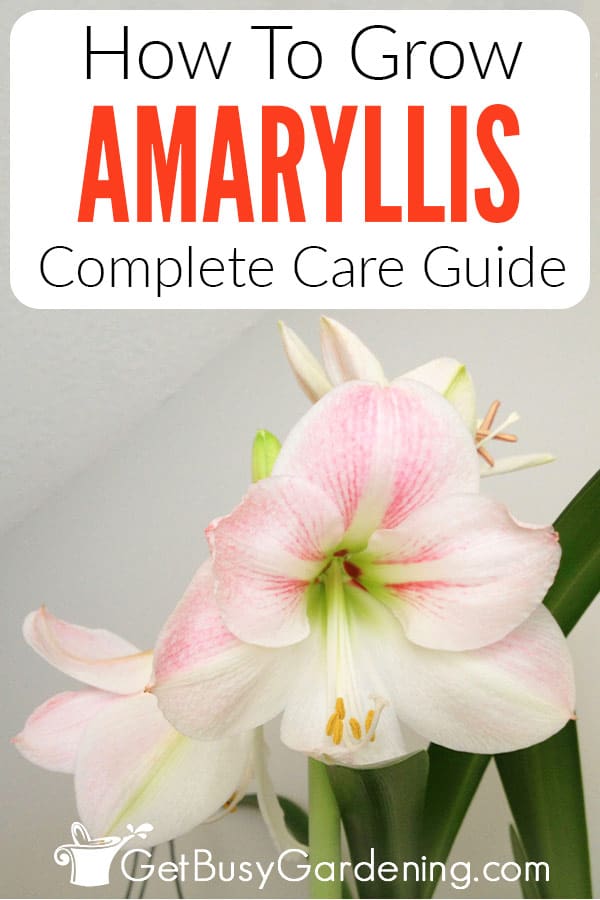

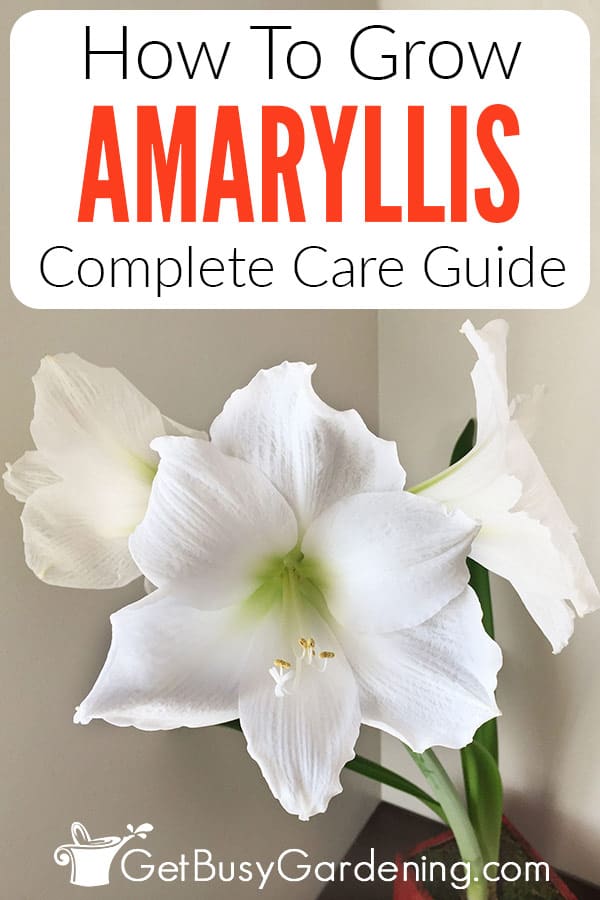
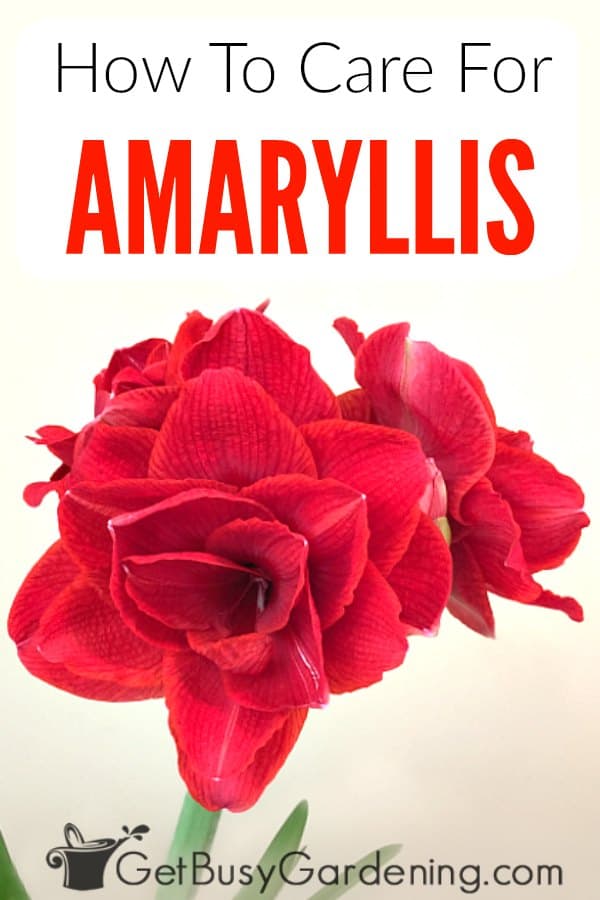



Jennifer says
How do you store them over the summer if you are forcing them to bloom in winter?
Amy Andrychowicz says
You keep them growing over the summer so they can build up energy to bloom again next year. You can keep them as houseplants indoors, or put them outside. They need lots of sun. This post will give you all the details… What To Do With An Amaryllis After It Blooms.
David says
Hi, my amaryllis is not waking up from its dormant stage, this is it’s second year. what is the problem and how do I fix it?
Amy Andrychowicz says
Make sure your amaryllis has plenty of light and warmth, they won’t grow it if it’s too dark or cold. Put it in sunny window or use a grow light to supplement. You can also place the pot on a heat mat to help it break dormancy faster. Here are a few posts that will give you more details…
– Dormant Amaryllis Care, Timing, Preparation, & How To Revive It
– How to Rebloom Your Amaryllis Step By Step
Donnetta Tullis says
My amaryllis budded but didn’t flower. The buds turned yellow and are dieing. Some of the leaves are turning yellow also. I planted them about 5-6 years ago outside. And they’ve thrown off a new plant each year.
.
Amy Andrychowicz says
If the flower bud turned yellow before opening and the leaves are also yellowing, then your amaryllis plant is likely getting too much water. The soil should never be wet, it should stay on the dry side, especially during cooler weather.
Mary Atkins says
I have a second spike starting on my amaryllis. Do I leave the first spike while the second blooms where I have pruned off the dead flowers or should I go ahead and prune the first spike back to the top of the bulb while I enjoy the second one?
Amy Andrychowicz says
I always leave my amaryllis flower spikes in tact until they turn yellow and start to shrivel (or until the turn brown and die), that will help it regenerate energy for next years blooms. However, since it has a second spike, you could cut off the first one if you don’t like how it looks. Then leave the second one on until it turns brown. Here’s more information about how to care for amaryllis after flowering.
Deborah Thompson says
Hi there – I am a late-bloomer to the joys of growing Amaryllis – I bought two that were on sale in boxes at a hardware store near me – one white and one red. The white one (I didn’t keep the box to know what it was, I’m so sad!) was SOOOO spectacular. The blooms were the most enormous flowers I’ve ever seen. They lasted about six weeks under a grow light in my office at work. Now the red one is blooming but I have it at home and I’m not sure if I need to keep it under grow lights to keep the flowers opening and healthy? I live in the Pacific Northwest of Canada and this time of year we are lucky to have even one day of sunlight in a week or two. It rains constantly. So natural light is not very good for plants in my house….. I have grow lights in the basement but I will not be able to see the beauty of the flowers if I keep it down there :(. Thanks for any reply.
Amy Andrychowicz says
Yay, so glad you’ve been enjoying your amaryllis plants, aren’t they fantastic?! Unfortunately, the flower spikes do tend to get leggy and reach for the window if they’re not getting enough light. It should still bloom for you, but the stem may be pretty tall and weak. I would try putting in a south facing window where the sun is the brightest, and just keep an eye on it. They grow really fast, so if you notice it’s reaching and stretching, you should put it under your grow light. If you end up doing that, then just check on it daily to see if the flowers are about ready to open. Once they turn red and start opening, you can move it back upstairs where you can enjoy them. Have fun!
Deborah Thompson says
Oh, thank you so much for this information! Greatly appreciate it! I am in love with Amaryllis now and plan to keep buying more!
Nancy says
What is the proper way to store amaryllis bulbs over the winter (zone 6) so I can plant outside next year? I would like to dig up and store the bulbs to conserve space?
Amy Andrychowicz says
After digging them up, remove the leaves and let them cure (dry out). Then you can store them just like any other type of bulb. Or better yet, you could try reblooming them for winter flowers indoors, here’s how to do that.
Mary says
What if the plant has no leaves the second year? Use an extremely tall stem with 4 blooms.
Amy Andrychowicz says
It’s not uncommon for amaryllis bulbs to flower before they get any leaves. So give it time. The leaves will usually start to grow as or after the flower spike dies back. 🙂